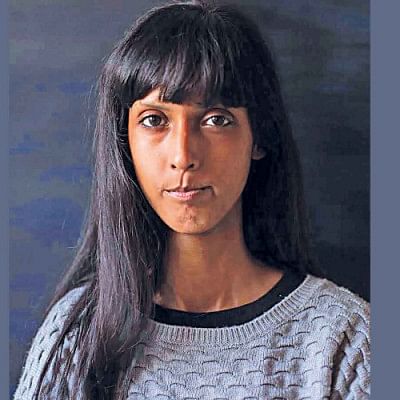Musings with artist Ayesha Sultana

Ayesha Sultana, an artist based in Dhaka, is recognised across the globe. She sets herself apart through her practice that is uncommon in the South Asian context. Her work has been showcased in Kiran Nadar Museum of Art in New Delhi, alongside the works of celebrated Indo-American artist and printmaker Zarina Hashmi, as well as artists Lala Rukh, Prabhavathi Meppayil, and Sumakshi Singh last year. In conversation with The Daily Star, Ayesha sheds light on her artistic journey.
She is hugely inspired by Indian artist Nasreen Mohamedi and Pakistani artist Rashid Rana. Her work is experimental and abstract to a great extent, involving different materials and processes.
Her school teacher, Fareha Zeba, recommended a South Asian foundation's art scholarship to her. As part of the first batch of the exchange programme, Ayesha arrived in Beaconhouse National University in Lahore in 2003. She spent the first night at artist Salima Hashmi's residence. Ayesha was set for a journey that she never expected.
"The visual arts curriculum of the programme was multidisciplinary with overlaps, and we were introduced to different techniques and ideas of various disciplines," she recalled. The first year was an emotional, yet exciting journey for her. Her tutors Huma Mulji, Rashid Rana and Salima Hashmi were truly nurturing. In 2009, Ayesha returned to Dhaka after completing her BFA and postgraduate diploma from Beaconhouse National University in Lahore. Ayesha also taught there for two years.
In 2014, she was honoured with The Samdani Art Award, as a part of which she went to Delfina Foundation for a three-month residency. She is a member of the artist-run organisation, Britto Arts Trust, based in Dhaka.
Ayesha's father was in the Bangladesh Air Force. He travelled extensively, and enjoyed clicking photos. Those images offered the initial windows of 'seeing' for her. Upon her return to Dhaka, she deliberately removed figures from her early practice and concentrated more on drawing that she calls therapeutic. "Painting takes a long time. Drawing, on the other hand, feels more freeing and immediate," she explained. Ayesha is quite minimalistic in her approach, experimenting with texture, objects, and spaces in mundane presentations.
She is also an avid notetaker, and maintains a 'dream journal'. "I remember my dreams quite vividly. I have assimilated these dreams notes in my work," she shared.
Her work of clay-coated paper was displayed at the Dhaka Art Summit in 2020. People usually enjoy the repetitions and rhythmic playing with light and darkness, in her works. The artist also loves working with paper and graphite. In her words, paper is a versatile and malleable object. She is known for her works based on shimmering, graphic-dusted surfaces of paper that are cut and reassembled in geometric forms, before being mounted on diamond paper.

During the conversation, Ayesha shared an anecdote from her childhood. "We lived in Kuwait and I distinctly remember the ray of light that traversed from my mother's bedroom to mine. That light remains an inspiration in my work," she said.
While visiting Italy around 2011, she was inspired to take up a monochromatic approach. She spent time there visiting churches and making sketches inside the ancient buildings. She also went to various painting exhibitions. "My most memorable visit was in Padova, Arena Chapel. I was completely blown away by the works of Giotto. I was not making art at the time, but I was thinking about it," she said.
Dhaka and its architecture play an integral role in Ayesha's works. In 2014, the artist had her first solo exhibition at Experimenter Gallery in Kolkata. The works on exhibit had references to corrugated tin sheets, commonly used for rooves and wall boundaries with the rhythm of their grooves, replicated on paper. Ayesha has two publications, "Form Studies" and "Napoli Drawings".
Ayesha's work has been supported by a number of galleries. She believes that the audience plays an important role in the presentation of her art. "With an ecosystem of artists and art supporters, often there are expectations to be met. However, an artist can still have the freedom of their practice," she explained. The artist is currently preparing for a solo exhibition at Experimenter Gallery in February.
The author is an art researcher and writer in the making. She can be reached at [email protected].

 For all latest news, follow The Daily Star's Google News channel.
For all latest news, follow The Daily Star's Google News channel. 



Comments